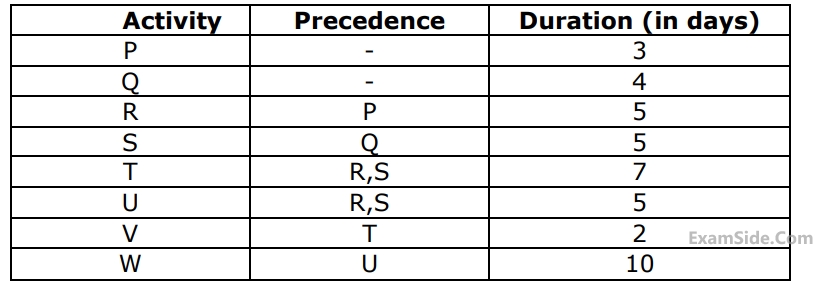The function
$${S_1}\,\,$$ (elevation : $$10$$ $$m$$ ) is the $$50$$ $$kPa.$$ At section
$${S_2}\,\,$$ (elevation : $$12$$ $$m$$ ) the pressure is $$20$$ $$kPa$$ and velocity is $$2$$ $$m/s.$$
Density of water is $$1000$$ $$kg/{m^3}$$ and acceleration due to gravity is $$9.8$$ $$m{s^{ - 2}}.$$ Which of the following is TRUE?
List-$${\rm I}$$
$$P.$$ Compressible flow
$$Q.$$ Free surface flow
$$R.$$ Boundary layer flow
$$S.$$ Pipe flow
$$T.$$ Heat convection
List-$${\rm II}$$
$$U.$$ Renolds number
$$V.$$ Nussult number
$$W.$$ Weber number
$$X.$$ Froude number
$$Y.$$ Mach number
$$Z.$$ Skin friction coefficient


If the Earliest Due Date $$(EDD)$$ rule is used to sequence the jobs, the number of jobs delayed is

Using the Shortest Processing Time $$(SPT)$$ rule, total tardiness is

Direct shear stress in $$MPa$$ in the most heavily loaded rivet is

Assuming force $$Vs$$ displacement curve to be rectangular, the work done in $$J$$ is

A shear of $$20mm$$ $$(S=20mm)$$ is now provided on the blade. Assuming force $$Vs$$ displacement curve to be trapezoidal, the maximum force (in $$kN$$) exerted is




$$\left( {\rm I} \right)$$ A heat source at $$1200$$ $$K$$ loses $$2500$$ $$kJ$$ of heat to a sink at $$800$$ $$K$$
$$\left( {\rm II} \right)$$ A heat source at $$800$$ $$K$$ loses $$2000$$ $$kJ$$ of heat to a sink at $$500$$ $$K$$
Which of the following statements is true?

$$h$$ is specific enthalpy, $$s$$ is specific entropy and $$v$$ the specific volume; subscripts $$f$$ and $$g$$ denote saturated liquid state and saturated vapour state.
The net work output $$(kJ/kg)$$ of the cycle is

$$h$$ is specific enthalpy, $$s$$ is specific entropy and $$v$$ the specific volume; subscripts $$f$$ and $$g$$ denote saturated liquid state and saturated vapour state.
Heat supplied $$(kJ/kg)$$ to the cycle is